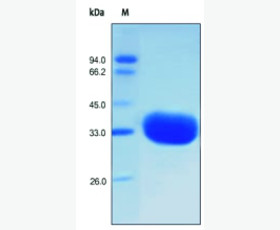Recombinant Human Transforming Growth Factor α/TGFα
| Product name: | Recombinant Human Transforming Growth Factor α/TGFα |
| Source: | E.coli |
| Purity: | Greater than 95% as determined by reducing SDS-PAGE. |
| Buffer Formulation: | Lyophilized from a 0.2 μm filtered solution of 10mM Acetic Acid . |
| Applications: | Applications:SDS-PAGE; WB; ELISA; IP. |
| Storage: | Avoid repeated freeze/thaw cycles. Store at 2-8 oC for one month. Aliquot and store at -80 oC for 12 months. |
| UOM: | 100ug/50ug/200ug/1mg/1g |
| Source | E.coli |
| Description | Recombinant Human Transforming Growth Factor alpha is produced by our E.coli expression system and the target gene encoding Val41-Val90 is expressed. |
| Names | Protransforming Growth Factor Alpha, TGF-Alpha, EGF-Like TGF, ETGF, TGF Type 1, TGFA |
| Accession # | P01135 |
| Formulation | Lyophilized from a 0.2 μm filtered solution of 10mM Acetic Acid . |
| Shipping |
The product is shipped at ambient temperature. |
| Reconstitution |
Always centrifuge tubes before opening. Do not mix by vortex or pipetting. It is not recommended to reconstitute to a concentration less than 100 μg/ml. Dissolve the lyophilized protein in ddH2O. Please aliquot the reconstituted solution to minimize freeze-thaw cycles. |
| Storage |
Lyophilized protein should be stored at < -20°C, though stable at room temperature for 3 weeks. Reconstituted protein solution can be stored at 4-7°C for 2-7 days. Aliquots of reconstituted samples are stable at < -20°C for 3 months. |
| Purity |
Greater than 95% as determined by reducing SDS-PAGE. |
| Endotoxin | Less than 0.1 ng/µg (1 IEU/µg) as determined by LAL test. |
| Amino Acid Sequence |
VSHFNDCPDSHTQFCFHGTCRFLVQEDKPACVCHSGYVGARCEHADLLAV
|
| Background | Transforming Growth Factor α (TGF-α) belongs to the EGF family of cytokines. It is a mitogenic polypeptide and secreted protein, which is expressed by monocytes, keratinocytes, and various tumor cells. TGFα contains two chains, protransforming growth factor α and transforming growth factor α. It can bind to the EGF receptor that synergistically with TGFβ to stimulate anchorage-independent cell proliferation and produce a mitogenic response. TGFα interacts with the PDZ domains of MAGI3, SDCBP and SNTA1. The interaction with SDCBP is required for the targeting to the cell surface. |














